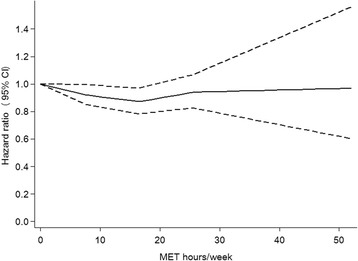Fig. 1.

Restricted cubic spline regression for the association between leisure-time exercise and risk of depressive symptoms. Footnote: Knots were placed in accordance with the current physical activity guidelines by the World Health Organization. The reference value is 0 MET hours of leisure-time exercise per week. The continuous line presents hazard ratios and the dashed line presents 95 % confidence intervals. The model was adjusted for age (year, continuous), sex, body mass index (<18.5 kg/m2, 18.5 to < 23 kg/m2, 23 to < 25 kg/m2, 25 to < 30 kg/m2, or ≥ 30 kg/m2), smoking (non-smoker, smoker consuming 1 to < 10, 10–20, or ≥ 20 cigarettes per day), alcohol consumption (non-drinker, drinker consuming < 1, 1 to < 2, or drinker consuming ≥ 2 go of Japanese sake equivalent per day, where 1 go of Japanese sake contains approximately 23 g of ethanol), shift work (yes or no), overtime work (<45 h per month, 45 to < 60 h per month, 60 to < 80 h per month, 80 to < 100 h per month, or ≥ 100 h per month), job position (high or low), marital status (unmarried, married, or divorced or bereaved), occupational physical activity (sedentary, standing or walking, or fairly active), commuting physical activity (<20 min, 20 min to < 40 min, or ≥ 40 min of walking to and from work), and baseline depression score (continuous)
